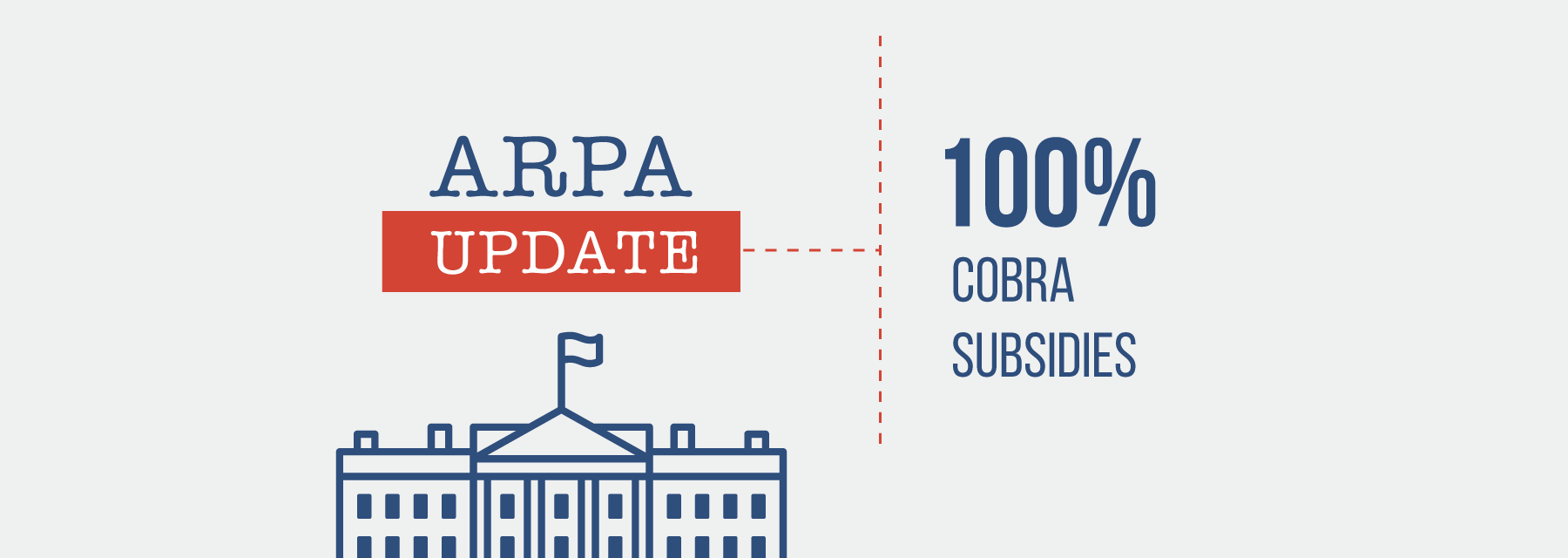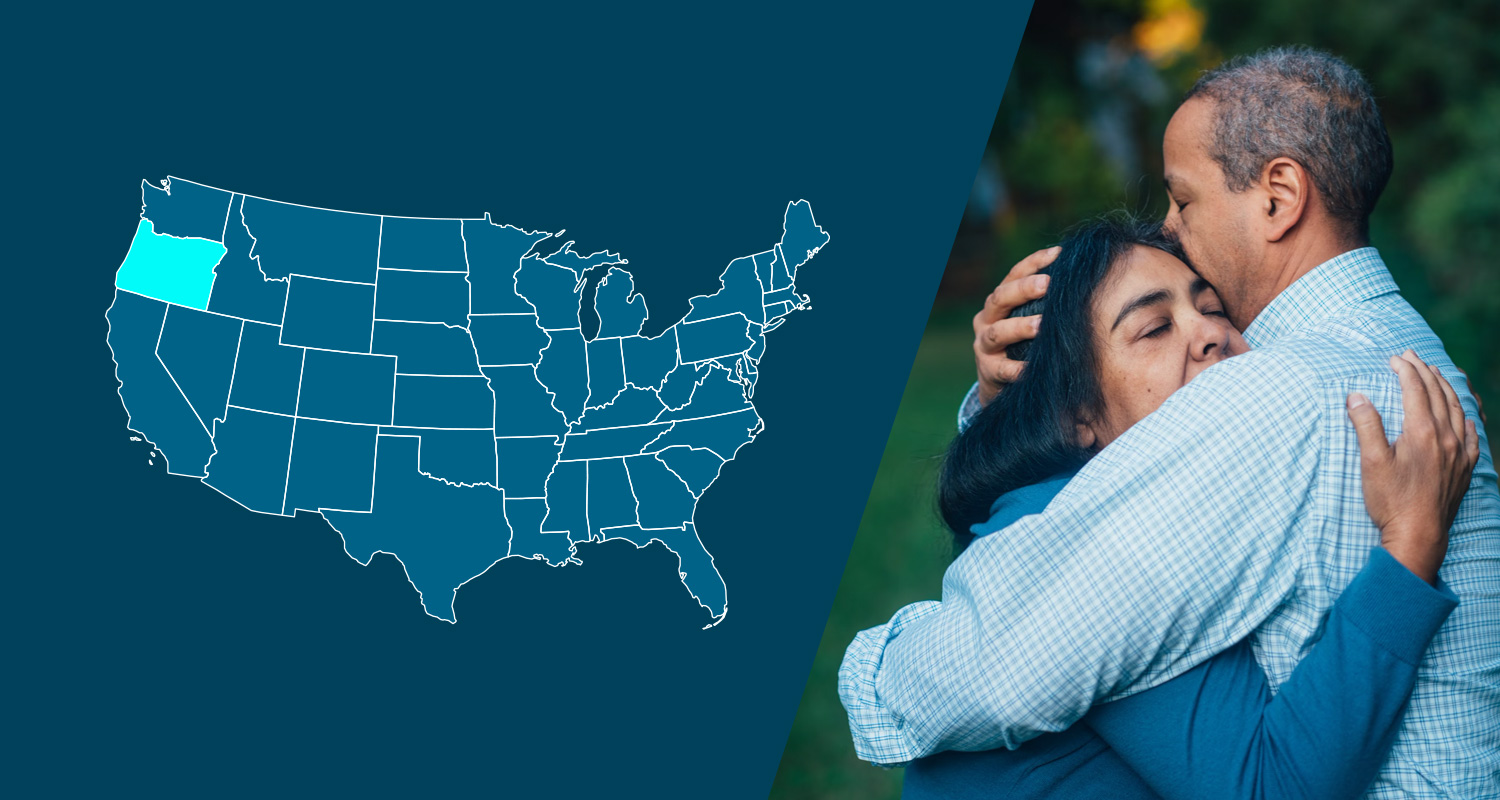https://www.dol.gov/agencies/ebsa/laws-and-regulations/laws/cobra/premium-subsidyUpdated 4/7/21 with guidance and model notices released by the Department of Labor.
Updated 3/18/21 with clarification on the time period employers should look at when determining which individuals are eligible for the 60-day special election period.
On March 11, 2021, President Biden signed the American Rescue Plan Act of 2021 (“ARPA” or “the bill”) into law, which includes a provision designed to provide up to 6 months of free COBRA coverage to employees and qualified beneficiaries (spouse and dependents) who lost (or lose) healthcare coverage due to a reduction in hours or involuntary termination. The bill will provide a 100% COBRA subsidy for “assistance eligible individuals” from April 1, 2021 through September 30, 2021 (“COBRA subsidy period”) for federal COBRA coverage and comparable state COBRA-like coverage.
How COBRA Subsidies are Provided
Individuals eligible for the COBRA subsidy (referred to as “assistance eligible individuals,” described below) must be provided free COBRA coverage for up to 6 months during the COBRA subsidy period (April 1, 2021 through September 30, 2021). Assistance eligible individuals will be treated as having “fully paid” the applicable premiums and the entity that individuals would have been required to pay COBRA premiums to (but for the ARPA) will essentially “advance” the amounts due. The entity will then be reimbursed for unpaid premiums in the form of a refundable quarterly payroll tax credit. For purposes of ARPA, the following entities will be eligible for the credit:
- The plan, for group health plans that are multiemployer plans (i.e., union plans);
- The employer, for group health plans that are not multiemployer plans and that are subject to federal COBRA or if some or all of the employer group health plan coverage is not provided by insurance (i.e., self-insured and level funded plans); or
- The insurer, who is providing coverage under a fully insured group health plan that is not described in (1) or (2) above (i.e., fully insured plans not otherwise subject to federal COBRA who may be subject to state-based COBRA continuation).
The payroll tax credit will equal the full amount of COBRA premiums not paid by assistance eligible individuals. If the amount of the credit exceeds the payroll taxes owed, any excess will be refunded to the eligible entity. In addition, the credit may be advanced under rules set out by the Department of Treasury. The Department of Treasury will be forthcoming with necessary regulations, guidance, forms, or instructions to carry out these payroll tax credits, including any reporting required to verify the amount of reimbursement.
Employers cannot claim a tax credit for COBRA subsidies on amounts they plan to receive a tax credit on through the CARES Act employee retention credit or through the Families First Coronavirus Response Act (as extended under ARPA). In other words, employers cannot claim a double credit on the same amount.
Individuals Eligible for Assistance
Individuals eligible for a subsidy (called “assistance eligible individuals”) are qualified beneficiaries (e.g., employee/former employee, and spouse/dependents who were covered immediately prior to the qualifying event) who lost (or lose) employer-sponsored healthcare coverage due to a reduction in hours or involuntary termination of employment and who are enrolled in COBRA during the subsidy period (April 1, 2021 through September 30, 2021). This includes individuals who:
- Are already enrolled in COBRA as of April 1, 2021 and will continue to be covered during any portion of the COBRA subsidy period;
- Become eligible for COBRA coverage on or after April 1, 2021 and before September 30, 2021 and enroll in COBRA during any portion of the COBRA subsidy period; and
- Are not enrolled in COBRA as of April 1, 2021 but who would have been eligible for a subsidy if they were enrolled (i.e., individuals who are still within their COBRA maximum coverage period) and who elect coverage during the special 60-day election window (discussed below). This includes individuals who were eligible to enroll in COBRA prior to April 1, 2021 and failed to enroll or terminated coverage prior to April 1, 2021.
The subsidy only applies to individuals who lost health coverage due to a reduction in hours or involuntary termination, though there is no requirement that the event be related to the COVID-19 pandemic (also note, the bill does not explicitly require the reduction in hours to be involuntary). This means individuals who lost coverage due to a voluntary termination or other COBRA qualified events (such as an employee’s death) are not eligible for the subsidy.
Special 60-day Election Period
ARPA provides a special election window for COBRA qualified beneficiaries who are not covered under COBRA as of April 1, 2021, but who would have been eligible for subsidies if they elected (or did not terminate) COBRA coverage. Only COBRA qualified beneficiaries who have not exhausted their original maximum coverage period (generally 18 months after the qualifying event under federal COBRA) can elect coverage during the special election period. It appears that the special election window only applies to federal COBRA coverage.
These individuals have 60 days from the date they receive the notice of the special election period (which employers must provide, as discussed below) to elect coverage. For those who elect, coverage would go into effect retroactive to April 1, 2021.
It is important to note that ARPA does not extend the normal COBRA coverage period, but only provides a special election period for individuals. Thus, coverage will not go beyond an individual’s original maximum period of coverage.
- Example: An employee is terminated from employment on January 1, 2020 and declines to enroll in COBRA coverage. If the employee elected COBRA coverage, their maximum period of coverage would have been until June 30, 2021 (18 months from January 1, 2020). Since they would have been eligible for COBRA subsidies during a part of the COBRA subsidy period (April 1, 2021 through September 30, 2021) if they enrolled when first eligible, they must be provided the ability to elect coverage effective April 1, 2021 through June 30, 2021.
Interaction with Special COBRA Deadline Extensions: The ARPA allows individuals to prospectively elect free COBRA coverage effective as of April 1, 2021, whereas the special COVID deadline extensions provided by the Department of Labor (DOL) in April 2020 requires individuals to retroactively enroll and pay premiums for coverage back to the date of their initial COBRA qualifying event.
Further, it would appear the ARPA would allow some individuals who have exhausted their one-year maximum extension another opportunity to elect COBRA during the special 60-day election window. For instance, an individual that was involuntarily terminated with an original deadline to elect COBRA coverage on March 30, 2020 would theoretically have until March 30, 2021 to elect coverage under the special COVID extension. If the individual did not elect coverage as of April 1, 2021, they would have another opportunity to elect coverage during the ARPA special 60-day election period (since they are still within their original 18-month maximum coverage period). If they elect, they will have coverage effective April 1, 2021 and until the end of their original 18-month maximum coverage period.
Additional guidance from the relevant agencies on the interaction between the ARPA COBRA subsidies and the DOL COBRA deadline extensions would be welcome, though have not been released. For more on the deadline extensions, see our blogs here and here.
Permitted Election Changes
Generally, COBRA qualified beneficiaries are entitled to elect continuation coverage for the plan they were enrolled in immediately prior to the COBRA qualifying event. Under the ARPA rules, employers may permit “assistance eligible individuals” to enroll in cheaper coverage offered by the employer and receive a COBRA subsidy for the newly elected coverage if:
- The new coverage provides more than “excepted benefits” and is not a qualified small employer health reimbursement arrangement (QSEHRA) or flexible spending arrangement (FSA);
- The premium for the new plan is not greater than the premium for the plan they were enrolled in at the time of the COBRA qualifying event; and
- The new plan option is offered to similarly situated active employees at the time of the election.
If an employer allows election changes, they must notify individuals of their ability to switch to a cheaper plan (this new notice requirement is outlined below). Individuals must change their election within 90 days of receiving their COBRA notice. We recommend employers check in with any applicable carriers, should they permit such option.
Availability and Duration of Subsidy
Eligible Benefits: The subsidy will apply to continuation coverage required under federal COBRA (except the subsidy will not apply to health FSAs) and will also apply to certain State programs requiring comparable coverage. This means the subsidy will likely apply to benefits provided under group health plans that provide medical care, including medical, dental and vision coverage and coverage through a health reimbursement arrangement (HRA) (but not life or disability plans since they do not provide medical care). As a reminder, plans sponsored by employers with 20 or more employees in the prior year are subject to federal COBRA, whereas plans sponsored by employers with less than 20 employees may be required to provide continuation coverage under state-based “COBRA-like” programs.
Duration: The subsidy is available to eligible individuals from April 1, 2021 through September 30, 2021. Subsidies can end prior to September 30, 2021 if:
- An individual’s original COBRA maximum period of coverage is exhausted; or
- An individual becomes eligible for group health plan coverage or Medicare (coverage consisting of only excepted benefits, such as limited scope dental or vision coverage, a healthcare FSA, or QSEHRA will not disqualify individuals from the subsidy).
The subsidies will end the first of the month of coverage after the individual exhausts the maximum coverage period or becomes eligible for another group health plan, whichever is earlier.
New Coverage Notification Requirement: Individuals must notify a plan if they become eligible for coverage under another group health plan or Medicare. The Department of Labor will specify when and the manner in which notice must be provided by the COBRA participant to the plan. Individuals who fail to notify a plan can receive a penalty of $250 and, for intentional failures, a penalty of up to 110% of the subsidy erroneously provided to the individual, unless the failure is due to reasonable cause and not willful neglect.
New Notice Requirements
ARPA requires several new notice requirements under federal COBRA, as outlined below. Employers who fail to provide the new information will be treated as failing to provide the requisite COBRA notices.
1. ARPA General Notice
Who: For individuals who experience a reduction in hours or involuntary termination between April 1, 2021 and September 30, 2021 and are entitled to COBRA coverage. This notice must include information on the availability of subsidies and the ability to change plan options (if allowed by the employer).
When: The election notices must be provided according to the normal timelines. Generally, employers who are plan administrators have 44 days to issue a COBRA election notice to qualified beneficiaries (30 days to notify the plan administrator + 14 days).
Content Requirements: The notices must include:
- The forms necessary for establishing eligibility for premium assistance;
- The name, address, and telephone number for the plan administrator maintaining information in connection with premium assistance;
- A description of the special 60-day election period;
- A description of the individuals’ obligation to notify the plan if they become eligible for coverage under another group health plan;
- A description of the qualified beneficiary’s right to a subsidized premium and any conditions to entitlement (displayed in a prominent manner); and
- A description of the option for the qualified beneficiary to enroll in different coverage (if allowed by the employer, as discussed above).
The new required information can be provided separately or with the COBRA election notice.
Model Notice: ARPA General Notice and COBRA Continuation Coverage Election Notice and Summary of the COBRA Subsidy Provisions under the American Rescue Plan Act of 2021 (must be sent with ARPA General Notice)
2. Notices of Extended Election Period
Who: Notice must be provided to assistance eligible individuals who had a reduction in hours or involuntary termination prior to April 1, 2021 and who are still within their COBRA maximum coverage period. This includes current COBRA participants and individuals who became eligible to elect COBRA before April 1, 2021 and did not initially elect coverage or terminated coverage prior to April 1, 2021.
When: The notice must be provided by May 31, 2021.
What: Model COBRA Continuation Notice in Connection with Extended Election Periods and Summary of the COBRA Subsidy Provisions under the American Rescue Plan Act of 2021 (must be sent with Extended Election Notice)
3. Notice of Expiration of COBRA Subsidies
Who: Notice must be provided to COBRA plan participants regarding the expiration of their subsidies. This notice does not need to be provided to individuals whose subsidies end because they become eligible for coverage under another plan.
When: Notice must be provided at least 15 day prior, but no more than 45 days prior, to the expiration of the subsidy.
Content Requirements: The notice must provide the following information, in clear and understandable language:
- Premium assistance for such individual will expire soon and the date of such expiration; and
- The individual may be eligible for coverage without premium assistance through COBRA or another group health plan.
Model Notice: Notice of Expiration of COBRA Subsidy
Impact on Employers
We expect additional guidance on the COBRA subsidies from the relevant government agencies in the coming weeks, which will hopefully shed light on administrative issues not addressed in the bill. Below, we outline actions items employers can take to prepare for the COBRA subsidy based on plain text of the bill. Though most employers outsource COBRA administration to vendors or third parties, they should be aware they remain responsible for compliance.
- Election Changes: Employers should determine whether they will allow “assistance eligible individuals” to switch to lower-cost coverage. Since employers are required to notify individuals of whether they can change their election, a decision must be made prior to furnishing the new notices. Employers should check with their carriers (if fully insured) or their stop-loss provider (if self-insured) to ensure these election changes will be permitted.
- Special Enrollment Window: Employers should identify individuals who are eligible for the 60-day election window and work with their vendor to notify these individuals of the availability of COBRA subsidies by May 31, 2021.
- Employers may need to look as far back as October 2019 to identify qualified beneficiaries (including employees, former employees, and their spouses and dependents) who experienced a reduction in hours, furlough, or involuntary termination that caused them to lose coverage. This is because COBRA coverage usually begins the first of the month following the termination or reduction in hours (i.e., November 1, 2019) and individuals would still be within their 18-month maximum coverage period during April 2021.
- Notice Requirements: Employers should work with their COBRA vendor to provide the new required notices to individuals eligible for the subsidy. Employers may want to wait until the model notices are provided.
- Tracking of COBRA Subsidy Amounts: Employers should work with their COBRA vendor to track COBRA subsidy amounts so they can receive credits for those amounts on their quarterly payroll taxes. Employers should look for additional guidance from the Department of Treasury on how to substantiate reimbursements for the tax credit.
We will provide further updates as new guidance is released.
Additional Resources
- American Rescue Plan Act of 2021
- DOL FAQs for Workers
- DOL Model ARPA COBRA Notices
- Sequoia Foreword: Biden Stimulus Package: Impact on Employer-Provided Benefits
- Sequoia Foreword: Agencies Clarify End Dates for COVID-19 Deadline Extensions
- Sequoia Foreword: COVID-19 Deadline Relief for Employers, Participants, and Beneficiaries
Disclaimer: This content is intended for informational purposes only and should not be construed as legal, medical or tax advice. It provides general information and is not intended to encompass all compliance and legal obligations that may be applicable. This information and any questions as to your specific circumstances should be reviewed with your respective legal counsel and/or tax advisor as we do not provide legal or tax advice. Please note that this information may be subject to change based on legislative changes. © 2021 Sequoia Benefits & Insurance Services, LLC. All Rights Reserved




